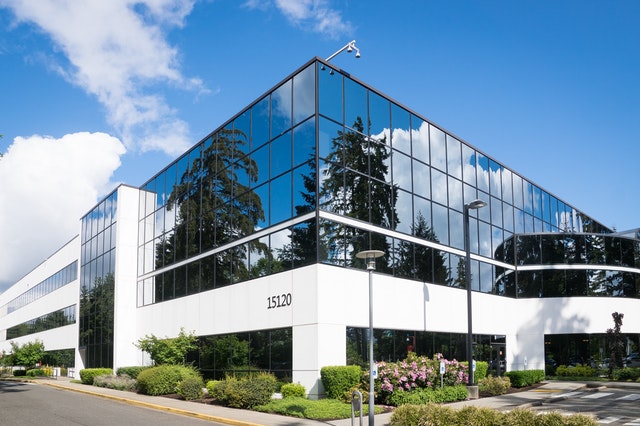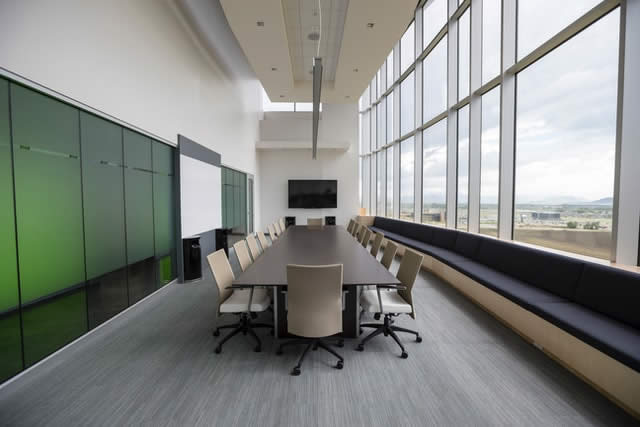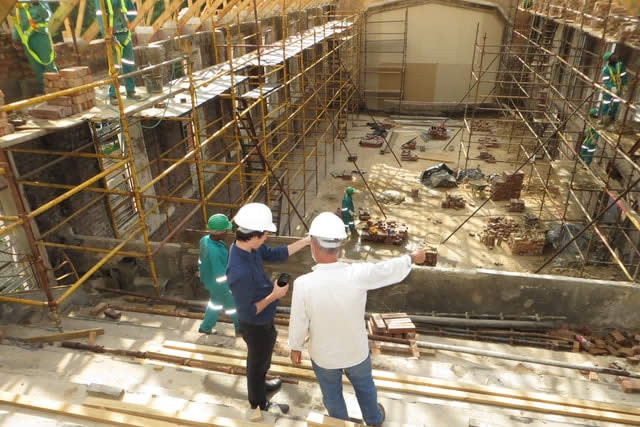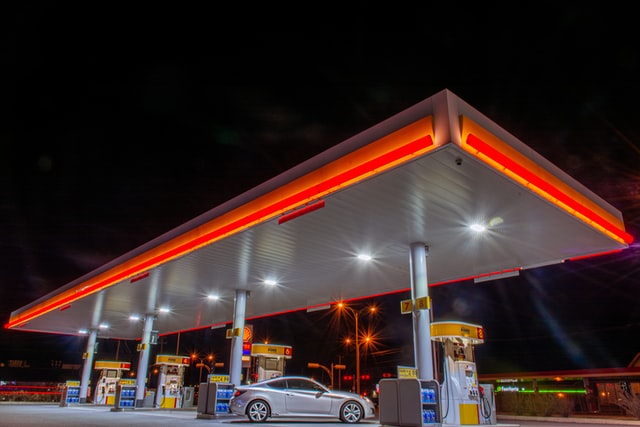Americans spend most of their time inside buildings. We take for granted the shelter, protection, warmth, coolness, air, and light that buildings provide, and rarely give a thought to the systems that deliver these services unless there’s a power interruption or other problem. In addition, few Americans understand the environmental consequences of maintaining indoor comfort levels.
Today’s buildings typically use mechanical equipment powered by electricity and fossil fuels for lighting, heating, cooling and maintaining air quality. Fossil fuels burned to generate electricity and condition buildings emit other pollutants that cost citizens and insurance companies millions of dollars in healthcare costs each year. Mining and extraction of fossil fuels also have environmental impacts, and instability in pricing causes concern among both business people and homeowners. Creating buildings that use less energy not only reduces and stabilizes costs but also reduces environmental impact.
The good news is that we have the knowledge and technologies to reduce energy use in our homes and workplaces without compromising comfort and aesthetics. The bad news is that we are not taking full advantage of these advances—buildings are typically designed and operated without considering all their environmental impacts.
Whole-Building Design
For decades, researchers and innovative designers and builders have created buildings that treat the environment as a resource, rather than as an obstacle to be overcome. Over the years, building professionals have steadily refined the equipment and design strategies used in these environmentally responsive buildings. This evolutionary process and the resulting body of knowledge have led to the concept of “whole-building” design.
In the whole-building approach, designers create a computer model of a structure during the early stages of the design process. Using this model, together with improved communication among the various players in the design/build process, designers can integrate disparate building elements into the most energy-efficient, cost-effective and comfortable building possible. The goal is to minimize the building’s impact on the environment, and, quite often, the results are remarkable, resulting in dramatic savings in energy use without a substantial increase in design or construction costs. As a bonus, these buildings can improve the health, comfort, and productivity of their occupants in measurable ways. In commercial buildings, dollar savings from increases in productivity and reduced absenteeism can dwarf savings from reduced energy use.
In 1998, the U.S. Department of Energy (DOE) began working with the commercial buildings industry to develop a 20-year plan for research and development of energy-efficient commercial buildings. More than 250 people from 150 building organizations worked together to create a technology roadmap report which recommends strategies for making commercial buildings more energy-efficient. The overall goal of the DOE’s High-Performance Buildings Program is better buildings that save energy and provide a quality, comfortable environment for workers. The program targets the building community, especially building owners, engineers, and architects. Building professionals are encouraged to submit plans for new commercial buildings to be a part of the High-Performance Building program. To participate, you must start very early in the design phase—before any other work is done—and must anticipate a 70% or more energy cost-reduction.
The DOE High-Performance Buildings Program
Design Approach
Although there’s no concrete definition of a high-performance building, Commercial Property Inspections of Atlanta defines it as a building with energy, economic and environmental performance that is substantially better than standard practice. It’s energy-efficient, so it saves money and natural resources. It’s a healthy place to live and work for its occupants and has a relatively low impact on the environment. All this is achieved through a process called whole-building design.
Design Guidelines
Whole-building commercial design considers all building components during the design phase. It integrates all the sub-systems and parts of the building to work together. Because all the pieces must fit together, it is essential that the design team be fully integrated from the beginning of the process. The building design team can include architects, engineers, building occupants and owners, and specialists in areas such as indoor air quality, materials, and energy use.
This approach brings together building design, energy efficiency, and today’s solar technologies to boost your energy savings and make the most of all your building’s elements. It reduces the amount of energy required to operate a building compared to conventional buildings. It improves the comfort of building occupants by using aesthetically pleasing architectural designs to brighten up work areas using sunlight rather than electricity, without causing excess glare.
What are the benefits of whole-building design?
Commercial buildings consume 17% of the total energy consumed in the United States. By creating buildings that use less energy and have lower power demands, greater robustness of the buildings (as well as the power grid) is achieved. This reduces the need for fossil fuels and consequential environmental impact.
- reduced energy use by 50% or more;
- reduced maintenance and capital costs;
- reduced environmental impact;
- increased occupant comfort and health; and
- increased employee productivity.
Employee productivity and business profitability are linked. Recent studies have shown an increase in employee productivity when buildings are designed with occupants in mind—natural light, comfortable temperatures, and a quiet work environment being their most important issues. Research suggests that a well-designed workplace can increase employee productivity by 20%. Furthermore, studies also show that a pleasant indoor building environment helps attract desirable tenants for building owners, increasing the number of potential renters for a building.
How much does it cost?
There is a growing interest today on the part of commercial building owners, facilities managers, architects, engineers, and builders to design and construct the best possible building for the allotted budget. Depending on the aggressiveness of the design, experience has shown that it costs no more than 10% more to build high-performance buildings. Some high-performance buildings cost less to construct. Sometimes, additional costs can be procured using cost-benefit ratios and life-cycle costing. The added cost (if any) of system investment each year is compared to the cost of fuel saved each year. Total energy costs are, on average, about 50% less than those for conventionally designed buildings. In many cases, the right-sizing of mechanical systems through passive solar design offsets the costs for additional windows and controls.
Design Approach: Frequently Asked Questions
Many owners want to make a statement with whole-building design and sustainable features. Many other owners, however, are creating these buildings at little or no additional cost that appear no different from conventional designs.
Energy-efficiency does figure prominently in our designs, but there are many other aspects to design. The whole-building concept looks to integrating all disciplines to meet a set of goals for a building.
Many of the early adopters were municipalities and government agencies that recognized the opportunities for life-cycle cost savings. Anyone can benefit from whole-building design.
Yes. Corporations, universities, and government agencies are demonstrating that whole-building design can provide better working environments and cost less to operate. Students, employees, and non-profit community groups are all demanding and campaigning for the adoption of low-energy buildings.
Not necessarily. Some prescriptive requirements, such as use of photovoltaics, may initially drive project costs somewhat higher, but several owners have published data demonstrating their success in procuring green buildings for less than the cost of a conventional building. Look around for incentives. These include incentives from local utility companies tied to energy-efficiency, grants for renewable energy installations, and various tax rebate programs.
Most projects have achieved good performance using conventional building systems. In many instances, it is the effective integration of conventional systems, rather than the use of a new technology, that conserves resources and improves environmental quality. New technologies are used only after careful consultation with owners and the design team.
Whole-building projects are demonstrating that it’s not hard. For example, the fact that very few commercial buildings employ natural ventilation does not mean that it cannot effectively deliver satisfactory comfort year-round in many climates. In many circumstances, the techniques were used extensively before widespread use of air conditioning.
Removing highly toxic chemicals from a product or designing a fixture to use less water does NOT mean that the product will be less effective or have a shorter life.
Design Guidelines
A high-performance commercial building design strategy requires a clear definition of goals and performance benchmarks from the owner, and an inter-disciplinary design and construction approach. Design criteria should be based on environmental and energy cost/benefit analyses and attention to whole-building and system performance
Pre-Design
Because all commercial building components must work together successfully long after project completion, it is essential that sufficient time is set aside in the beginning of a project for design team development, goal-setting, and project planning. A sustainable building can only be accomplished when everyone (the building owner, future occupants, design team) have the same energy and environmental goals for the project from the start. In short, everyone who is affected by this building in a decision-making position should be involved at the project’s beginning. Ultimately, the building owner is responsible for setting the goals and their implementation. It is the design team’s responsibility to translate goals and budget for the project into measurable benchmarks for design, construction, and operations so the project will be successful.
Design
Traditionally, commercial building design choices are based on budget and/or time considerations. Single-building components are added or deleted to meet time or budget constraints without evaluating their impact on total building performance. Yet, basic design goals, such as minimizing energy consumption or maximizing daylight, cannot be done without understanding the impact of interrelations between the parts of the building, including window-glazing systems, the thermal envelope, mechanical system-integration, orientation, and floor-plate proportions. High-performance building design must ensure complete integration to achieve optimal building performance. These interrelations are very complex. As a result, computerized simulation studies are necessary to properly account for interrelationships. Water and resource conservation, along with recycled, reusable and non-toxic, sustainable materials should also be considered in the design stage.
Construction
Building construction is an act of creation that begins long before the first shovel pierces the ground. It begins with a statement of design intent, followed by the creation of a performance program. Once these are approved, the process concludes with drawings and specifications, and then, finally, building commissioning during occupancy. Although simplified, below are some general guidelines:
Statement of Intent
A good statement of intent will clearly set forth the goals of the project, and current and possible future use for the building, as well as a description of how building systems are to perform. Clearly defined goals and objectives here will help in the bidding process later on.
Performance Program
The performance program is the strategy for implementing the goals established by the statement of intent, such as budget, space planning, integrated building systems, and other specific needs. It will also set performance goals for systems, such as lighting wattage per square foot, and include such amendments as the elimination of toxic materials. Several building rating systems exist that can be used to write the performance programs, such as the U.S. Green Building Council’s Leadership in Energy and Environmental Design, or the LEED rating system.
Drawings and Specifications
These record the design intent. Most design firms use the format created by the Construction Specifiers Institute (CSI). However, keep in mind that for high-performance buildings, you will need to add “integrated systems drawings” and supporting documents that will illustrate how different building components relate to and impact each other. Specifications that accompany the drawings must clearly explain the design intent, especially if a project includes unusual or innovative practices or requirements.
Building Commissioning
This is the process of ensuring that building systems, such as air-handling equipment, security systems, and elevators, are designed, installed, functionally tested and capable of being operated and maintained according to the owner’s operational needs. Commissioning begins in the design stage and extends at least one year into the initial occupancy of the building. This process ensures that the building is operating as designed. It also saves building owners money by keeping equipment and building systems compliant with warranties, prevents future excessive repairs, reconfiguration and replacement costs, employee absenteeism due to uncomfortable work environments with poor air quality, and frequent tenant turnover.
In summary, the construction of high-performance buildings has numerous benefits, such as the dramatic reduction of greenhouse gas emissions and energy savings.
About the Commercial Property Inspection
The inspection will be performed in accordance with the International Standards of Practice for Inspecting Commercial Properties (ComSOP) — an industry-accepted guideline and a proven process and system.
The commercial inspection is a thorough visual examination of the condition of a property. It provides an inventory of the building’s major systems and components, and an assessment of their physical and functional condition. These findings will reveal the property’s strengths and potential deficiencies, as well as deferred maintenance issues.
All commercial buildings have limitations and are generally costly to maintain and repair. The commercial property inspection will help the client better understand how well the property is holding up, as well as give them a good idea of anticipated maintenance and repairs moving forward from the day of the walk-through survey.
Schedule with Commercial Property Inspections of Atlanta
Regardless of the scope of the inspection ordered, the commercial inspection report will describe physical deficiencies that could potentially create the need for an expensive repair and/or risk the safety of building’s occupants. Every commercial property inspection project is different. Contact us to discuss the specific needs for your project, and learn more about commercial building inspections and how to prepare for a commercial property inspection.
Keep in mind, a commercial property inspection will pay for itself many, many times over. It is crucial when assessing the strength and long-term viability of a capital asset.





